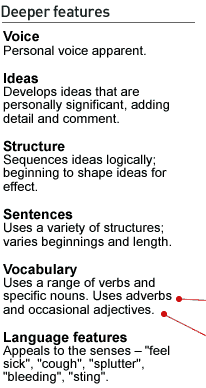


Rosemary depicts a moment that was enormously important to her. She establishes and maintains the mood of this experience vividly, writing a series of short and almost staccato sentences, in the present tense, that build up a sense of urgency. She controls the flow well, from the initial rhetorical question to the satisfying ending.



The teacher shared a personal experience of a scary moment and then asked the students to recall a situation in which they had felt scared. They sat in a circle and were invited to share their personal experience with the person on their left. Some volunteered to share their story with the whole group.
The teacher then asked them which language features would be useful to bring their story alive for the reader. The class identified:
• setting the mood
• hooking the reader in
• similes
• describing feelings and body positions
• using present tense.
These became the success criteria for their writing. They wrote for approximately 20 minutes and then shared some of their writing. The teacher selected one piece and, with the student's permission, displayed it as a model and discussion piece. This was reworked by the class, who discussed it against the success criteria.
The students then went on to rework their own pieces.
Teacher-student conversations
After the teacher had given specific written feedback on Rosemary's first draft, they discussed her work:
Teacher: Can you explain to me what your body was actually doing at this point [the beginning]?
Student: I was kicking my feet.
Teacher: It might be a good idea to explain that to your reader, so we get a really accurate image of you.
Student: I could put something about that in.
Teacher: Why do you think you cried at this point? How were you feeling?
Student: I was scared, but it was really the salty water stinging my eyes that made me cry.
Teacher: These details are really helping build up that picture.
Rosemary reworked her piece independently and added more detail.
Integrating reading and writing
During close and shared reading sessions students can be encouraged to identify language features and literary devices that might enhance their own writing.
These features and devices might include:
• ways of shaping and sequencing ideas
• a variety of sentence forms and beginnings
• specific nouns, verbs, adjectives and adverbs
• language features such as metaphors and personification.
Teachers could direct students to specific stories and extracts that are good models of effective descriptive writing, for example, from the School Journal or The Journal of Young People's Writing, and extracts from novels.
To move Rosemary towards the next learning step, the teacher might encourage her to focus on:
• Structure - organising ideas into paragraphs.
• Language features - using metaphors, similes, and dialogue if appropriate.
• Vocabulary -becoming discerning in choice, e.g., is "humungus" the best word?
This could be achieved through:
• modelling writing to specific points
• regular individual conferencing to develop specific areas in her own writing
• a close-reading programme that identifies and explores writing features. This could include texts published by other students.